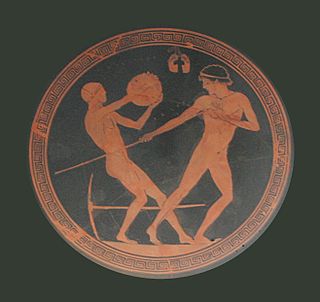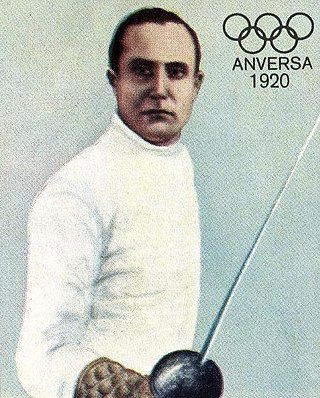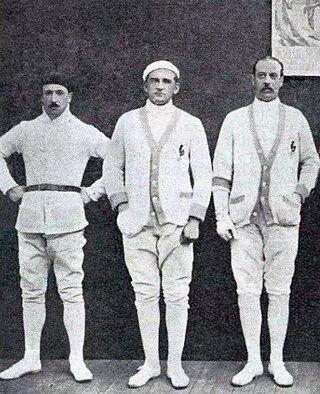
The 1920 Summer Olympics, officially known as the Games of the VII Olympiad and commonly known as Antwerp 1920, were an international multi-sport event held in 1920 in Antwerp, Belgium.

A pentathlon is a contest featuring five events. The name is derived from Greek: combining the words pente (five) and -athlon (competition). The first pentathlon was documented in Ancient Greece and was part of the Ancient Olympic Games. Five events were contested over one day for the Ancient Olympic pentathlon, starting with the long jump, javelin throwing, and discus throwing, followed by the stadion and wrestling. Pentathletes were considered to be among the most skilled athletes, and their training was often part of military service—each of the five events in the pentathlon was thought to be useful in war or battle.

Edoardo Mangiarotti was an Italian fencer. He won a total of 39 Olympic titles and World championships, more than any other fencer in the history of the sport. His Olympic medals include one individual gold, five team golds, five silver, and two bronze medals from 1936 to 1960, making him the most decorated Italian Olympian of all time and tied for the tenth-most decorated Olympian of all time.

Hungary first participated at the Olympic Games at the inaugural 1896 Games, and has sent athletes to compete in most Summer Olympic Games and every Winter Olympic Games since then. The nation was not invited to the 1920 Games for its role in World War I, and was part of the Soviet-led boycott of the 1984 Summer Olympics.
At the 1920 Summer Olympics, six fencing events were contested.

France competed at the 1920 Summer Olympics in Antwerp, Belgium. 304 competitors, 296 men and 8 women, took part in 113 events in 23 sports.

The United States competed at the 1920 Summer Olympics in Antwerp, Belgium. 288 competitors, 274 men and 14 women, took part in 113 events in 18 sports.

The Netherlands competed at the 1920 Summer Olympics in Antwerp, Belgium. 130 competitors, 129 men and 1 woman, took part in 58 events in 15 sports.

Belgium was the host nation for the 1920 Summer Olympics in Antwerp. 336 competitors, 326 men and 10 women, took part in 121 events in 23 sports.

Denmark competed at the 1924 Summer Olympics in Paris, France. 89 competitors, 78 men and 11 women, took part in 60 events in 13 sports.

The Egyptian Olympic Committee considers the nation to have first competed in the Summer Olympic Games at the 1912 Summer Olympics in Stockholm, Sweden. According to the official report, the nation sent one fencer, Ahmed Hassanein, who competed in the individual foil and épée events. There is uncertainty, however, as to whether he competed, as the official report lists all entrants in fencing regardless of their actual participation, and no results are known for Hassanein.

Paul Eugène Albert Anspach was a Belgian épée and foil fencer who competed in four consecutive Olympics.

The men's foil was a fencing event held as part of the Fencing at the 1920 Summer Olympics programme. It was the fifth appearance of the event. A total of 56 fencers from 10 nations competed in the event, which was held on August 17 and August 18, 1920. Nations were limited to eight fencers each, with Belgium and Italy entering the maximum. Nedo Nadi of Italy repeated as Olympic champion, retaining the title he initially won at the 1912 Summer Olympics. Philippe Cattiau and Roger Ducret of France earned silver and bronze, respectively, returning France to the podium for the first time since 1900.
The men's team foil was a fencing event held as part of the Fencing at the 1920 Summer Olympics programme. It was the second appearance of the event, which had been introduced in 1904 but not held in 1908 or 1912.

The men's épée was a fencing event held as part of the fencing at the 1920 Summer Olympics programme. It was the fifth appearance of the event. A total of 80 fencers from 13 nations competed in the event, which was held from August 20 to 23, 1920. Each nation was limited to eight fencers, down from 12 in 1908 and 1912. Of the six fencing events, the only one in which Nedo Nadi did not win a gold medal was the one in which he did not compete. Instead, a trio of Frenchmen swept the medals. It was Lippmann's second silver medal in the event, he having previously taken second in 1908; he was the second man to win multiple medals in the individual épée.

The men's sabre was a fencing event held as part of the Fencing at the 1920 Summer Olympics programme. It was the sixth appearance of the event. A total of 43 fencers from 9 nations competed in the event, which was held on August 25 and August 26, 1920. Nations were limited to eight fencers each. The event was won by Nedo Nadi of Italy, one of his five gold medals in 1920. His brother Aldo Nadi took silver. Adrianus de Jong of the Netherlands finished third. They were the first medals in the individual men's sabre for both countries. This was the only time from 1908 to 1964 that Hungary did not win the men's sabre—with no Hungarian fencers competing after the nation was disinvited after World War I.
The men's team sabre was a fencing event held as part of the Fencing at the 1920 Summer Olympics programme. It was the third appearance of the event.

Armand Émile Nicolas Massard was a French épée fencer who competed at the 1920, 1924 and 1928 Summer Olympics. In 1920 he won an individual gold and team bronze medal, and in 1928 he earned a team silver medal.
Fernand Alphonse Marie Frédéric de Montigny was a Belgian fencer and hockey player. He won two silver medals and two bronze in fencing and a bronze in hockey. He was also the architect of the 1920 Olympic Stadium.

The men's team foil event at the 2020 Summer Olympics took place on 1 August 2021 at the Makuhari Messe. 27 fencers from 9 nations are expected to compete.
















